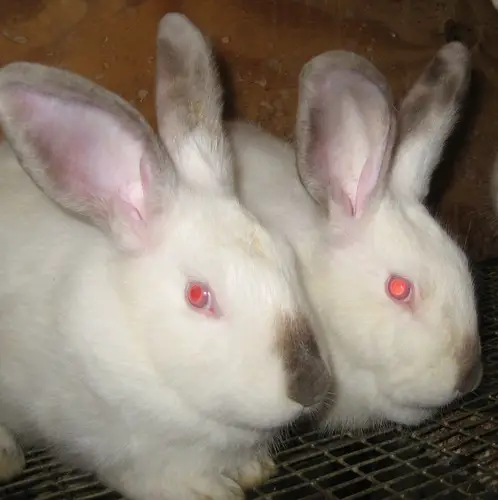Scientific Facts
| Common Name: | Altex Rabbit |
| Scientific Name: | – |
| Life Span: | – |
| Size: | Large (weighs 13 pounds) |
| Habitat: | Domestic areas |
| Country of Origin: | United States |
Fast Facts
| Best Suited For: | Avid rabbit keepers, novices, families |
| Temperament: | Docile, friendly, well-behaved |
| Comparable Breeds: | Albino Flemish Giant, Californian Rabbit |
Physical Description
The Altex is a big rabbit that typically weighs around 13 pounds. Bred and raised for its meat, this rabbit has full and fleshy build. Its ears are big and upright. It has a short coat and pure white fur. A mature Altex rabbit normally has grey ears and greying markings on its nose, tail, and feet.
With its white fur and grey streaks, the Altex rabbit looks like its Californian ancestor. It is the genetic stamp that has been developed to prevent confusion with the Albino Flemish Giant and the small Californian Rabbit.
Origin and History
To start with, the Altex rabbit is a commercial breed. The American Rabbit Breeders Association or ARBA and the BRC or British Rabbit Council do not recognize this breed. This rabbit was initially developed to produce sires or buck to help in breeding good meat rabbits that will be terminal crosses.
Terminal crosses aren’t for breeding. Instead, the whole litter will be sold for fur, meat, pelt, and for any other purposes, the breed had been created for. The terminal crossing is also known for its ability to help enhance hybrid vigor or heterosis, dress-out percentages, and weights of the resulting offspring.
The creation of the Altex rabbit was called the Altex project. It was created and managed by Steven Lukefahr. He was a professor from the Department of Animal and Wildlife Sciences in Texas A & M University Kingsville. His former students helped him with this project.
The Altex project started in 1986, and the resulting bunnies got the locations where they were developed – Alabama A&M University and Texas A&M University. Therefore, the “AL” is for Alabama, and “TEX” is for Texas.
The group gathered purebred Champagne d’Argent, Flemish Giant, and Californian Rabbits. These species came from fanciers and reputable breeders from various states of the United States and brought them together at Alabama A&M University in Huntsville, AL.
The researchers crossed the male Flemish Giants and Champagne d’Argent and Californian Rabbits. This cross formed 2 sets of initial crosses (the F1). Then, the males and females from that generation were crossed to produce the second cross (the F2). The second generation consists of ½ Flemish Giants, ¼ Californian bunnies, and ¼ Champagne d’Argent.
The F2 generation was used in assembling the genes from those 3 breeds of rabbits or sire characteristics: high dressing proportion, fast, effectual body gains, and high bone-to-meat ratio.
As expected, the F2 generation got different coat colors, traits, body types, fryer grow percentages and sizes because of their varying probabilities of the genetic compositions. On the other hand, with selective breeding for the 5 generations, the Altex was created.
Behavior and Temperament
As a pet, the Altex rabbit is rarely aggressive, easy to handle, and with a sweet, pleasing personality. This breed is calm and well-behaved. Like other rabbits, this breed is social and happy when kept in pairs or bigger groups.
With its sweet personality, this rabbit might bond closely to each other and form an almost inseparable bonded duo or group. If your pet is quite shy and feels uncomfortable with other rabbits, then it should have its cage. You should supervise it carefully until both rabbits get used to each other.
If you have just one rabbit, then keep in mind that your pet will require most of your time and attention for its human caretaker. However, human companionship can’t ever replace the interaction it could have with another rabbit.
On the other hand, a single rabbit will have no problem getting your attention and care. It will enjoy spending time with you on the couch and following it all over the kitchen.
Also, like other rabbit breeds, the Altex rabbit can be curious and playful. If you leave your pet out of its cage, it may come close to your visitors and greet them as they approach the door. It can also be friendly to other pets like cats and dogs. However, these animals may be tempted to prey on the rabbit.
Diet
The Altex rabbit is an herbivore. Its diet mainly consists of pellets, hay, and veggies. Hay is so crucial for the dental and digestive health of the rabbit. Grass hays like an orchard, timothy, and oat could be given to your pet in unlimited amounts. However, alfalfa is abundant in calories, so you should provide it to your pet only for some cases or as a treat.
You can also feed your Altex rabbit with fresh pellets every day. A high-fiber pellet will be great. Don’t provide mixes that contain other foods such as seeds, corn, and dried fruit.
Fresh foods are a crucial part of a rabbit’s diet. Feed your pet with dark and leafy greens such as romaine lettuce, kale, spring greens, and spinach. These veggies must make up 75% of your pet’s diet while other types of vegetables like cauliflower, broccoli, summer squash, and bell pepper must make up the remaining 25%.
Starchy vegetables and fruits must be limited in your pet’s diet. Give them to your pet as treats instead. When preparing the food, be sure to wash the fresh foods. Also, remove the unconsumed fresh foods and never allow your pet to eat them. Freshwater must be available in a water howl or sipper bottle.
Breeding
Altex rabbits may have up to 2 litters every year. Each litter may have 2 to 8 baby bunnies, 3 to 5 in most cases.
Housing
The Altex rabbit is best kept indoors. This will protect the animal against predators, extreme temperatures, or any other risks outdoors. When you buy a cage for your Altex rabbit, make sure it is large enough so that your pet can roam and exercise inside. The enclosure should be in the area where the animal can enjoy fresh air and sunlight.
You can also keep your Altex rabbit outdoors. Exercise pens, extension hutches, and lawn enclosures are suggested for safe external exposure. However, if you choose to keep your pet outdoors, then the enclosure must be 5x the rabbit’s size with more room to stand upright and stretch.
Wire mesh flooring must be prevented as it may cause injury and pain to the feet of your pet. A sleeping quarter or hide-away box must be given as a place where the animal can go to rest and sleep. Interesting items and baby toys must be available for entertainment. Another choice is to house your rabbit in the puppy-pen or play-pen.
Most rabbits could be taught to use a litter box. The non-toxic litters are best to use for rabbits because they are safe and dust-free. Pellets, reusable paper litters, citrus-based litters, aspen shavings, compressed wood pellets, newspaper, and hay are great choices. Don’t use clumping litters because they may clump in the digestive tract when eaten. Also, don’t use cedar or pine wood shavings.
Likewise, you should allow your pet to roam indoors for as long as there are no items that can harm your pet. Make your home rabbit-proofed. If you allow your pet to roam, then you should provide it a hutch where it can go whenever it feels uncomfortable or wants to sleep.
Common Health Concerns
Rabbits of all breeds can be prone to viral infections and colds. Exposure to draft, unexpected temperature changes, and stress can significantly lower your pet’s resistance against sickness. Your pet can also be prone to conjunctivitis, the bacterial infection caused by dust, smoke, and fumes. Also, it may acquire ear mites. Intestinal problems such as coccidiosis, bloating, or hairball obstructions are common in any rabbit, too. Also, check your pet’s teeth.
The Altex Rabbit as a Pet
Rabbits are known to be intelligent. They enjoy learning some tricks. This is true for most breeds, including the Altex. Most rabbits could also be trained to make use of a litter box. Rabbits like to dig and chew. It is important for the rabbits’ dental health. They always want to have something that they can chew and gnaw on. Therefore, you have to keep them safe from those items they should not chew.
Grooming
Grooming your Altex rabbit includes trimming and brushing its fur. You also need to clean its eyes, ears, and check the bottom side and the nails. Trim the nails if they are long. Inspect the teeth as well. By keeping your pet well-groomed, you can easily keep it healthier and happier.
Spaying/Neutering
Rabbits may also spray in making their territories, but you can reduce or eliminate this behavior through neutering and spaying. Neutering or spaying can lead to a better temperament and minimal behavioral problems.
They are so active in the sunset and daybreak. The Altex rabbit is physically fragile and prone to stress. So, if you have kids at home, you must supervise them when handling the rabbit.
How to Care for an Altex Rabbit?
Rabbits like Altex have dynamic and unique personalities. They can develop a close and loving relationship with their keepers. Many could be taught to use a litterbox and might enjoy learning some tricks. Aside from the fact that rabbits are quiet, they need little space and don’t exude any foul-smelling odors. Therefore, it is not hard to see why rabbits became the 3rd most famous pet in Great Britain and the United States.
Altex rabbits are not demanding. They are so easy to handle. They love being handled and played with their favorite humans. They will keep you happy and entertained whenever you play with the rabbit.
To keep your pet happy and healthy, you just need to make sure you meet all its needs. Give it a nice and safe enclosure, fresh foods, and clean water.
Where to Get One?
Altex rabbits may be available in online pet stores and breeders. This breed is getting more and more common in most parts of the world, like in the US.
There are some things to keep in mind when picking a rabbit. Altex rabbits are playful, curious, and fun-loving. When you get one, make sure it is 100% healthy and active. Check the eyes for conjunctivitis or any eye problems. Also, inspect the ears and fur for mites. Inspect the rabbit thoroughly before taking it home.
Cost
Altex rabbits can be more expensive than other common rabbits. They are less common than other famous rabbits like the Blanc de Hotot. Therefore, you have to be ready with your pocket if you want to keep one or two.
Likewise, you need to consider the basic needs of your future Altex rabbits. You have to provide them a big enclosure, high-quality food, water dish, grooming supplies, toys, and a lot more. You may end up spending more than $200 on the daily needs of your pets, especially food.
Fun Facts About Altex Rabbits
- Altex rabbits are large rabbits. They weigh 13 pounds.
- These rabbits are not wild animals. They have been created for commercial purposes.
- Altex rabbits are the offspring of Champagne d’Argent, Flemish Giant, and Californian Rabbits.
- Though they are not created for the commercial pet trade, Altex rabbits can be good pets. They are easy to handle, well-tamed, playful, and curious. Their sweet personality is one of the reasons why Altex rabbits can make great pets.
FAQs
How long do Altex rabbits grow?
Altex rabbits are large mammals. They are fleshy rabbits as they weigh 13 pounds or even more in some cases.
Where do Altex rabbits originate?
Altex rabbits are not like the rabbits living in the wild as they are created due to terminal crossing. These rabbits are the offspring of Champagne d’Argent, Flemish Giant, and Californian Rabbits.
Can Altex rabbits make good pets?
Yes, Altex rabbits can be good pets. They are sweet, docile, playful, and easy to handle.
Can I keep my Altex rabbit outdoors?
Rabbits are best to keep indoors. However, if you prefer keeping your Altex rabbit outdoors, then you have to make sure its cage is sturdy enough and will keep the animal safe from predators.


